When writing a recent piece about Reverse Polish Notation, or RPN, as a hook for my writing I retrieved my Sinclair Scientific calculator from storage. This was an important model in the genesis of the scientific calculator, not for being either a trailblazer or even for being especially good, but for the interesting manner of its operation and that it was one of the first scientific calculators at an affordable price.
I bought the calculator in a 1980s rummage sale, bodged its broken battery clip to bring it to life, and had it on my bench for a few years. Even in the early 1990s (and even if you didn’t use it), having a retro calculator on your bench gave you a bit of street cred. But then as life moved around me it went into that storage box, and until the RPN article that’s where it stayed. Finding it was a significant task, to locate something about the size of a candy bar in the storage box it had inhabited for two decades, among a slightly chaotic brace of shelves full of similar boxes.
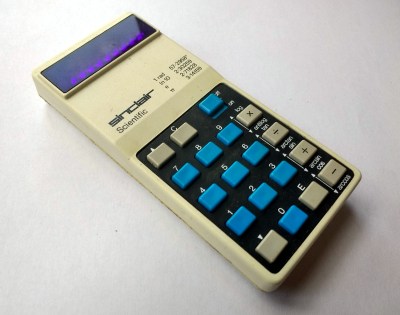
Looking at it though as an adult, it becomes obvious that this is an interesting machine in its own right, and one that deserves a closer examination. What follows will not be the only teardown of a Sinclair Scientific on the web, after all nobody could match [Ken Shirriff]’s examination of the internals of its chip, but it should provide an insight into the calculator’s construction, and plenty of satisfying pictures for lovers of 1970s consumer electronics.
The Sinclair is protected by a rigid black plastic case, meaning that it has survived the decades well. On the inside of the case is a crib sheet for its RPN syntax and scientific functions, an invaluable aid when it comes to performing any calculations.
It shares the same external design as the earlier Sinclair Cambridge, a more humble arithmetic calculator, but where the Cambridge’s plastic is black, on the Scientific it is white. The LED display sits behind a purple-tinted window, and the blue-and-black keyboard occupies the lower two-thirds of the front panel. At 50 x 111 x 16 mm it is a true pocket calculator, with an elegance many of its contemporaries failed to achieve and which is certainly not matched by most recent calculators. Good industrial design does not age, and while the Sinclair’s design makes it visibly a product of the early 1970s space-age aesthetic it is nevertheless an attractive item in its own right.

On the back there is only the clip-on cover for the battery compartment, which lies under the keyboard. Opening it reveals the underside of the keyboard PCB with a label showing battery orientation and the springy battery clips for a set of 4 AAA cells. One of the clips had been corroded by a leaking cell and had snapped when I got the calculator, necessitating a piece of copper foil between cell and clip for operation. The label recommends Duracell AAAs, which in the mid 1970s were not cheap. At rest the calculator draws 35 mA from them, so an owner without deep pockets would have had to ensure to turn it off immediately after calculations.
The upper and lower halves of the case are held together with moulded clips, meaning that with care they can be pried apart to reveal the circuitry. On this example one of the clips has been broken, sadly I can’t remember if this was caused by an enthusiastic but inept younger me. Once the rear panel has been removed, the 28-pin dual-in-line package of the TMS0805 calculator chip with its March 1975 date code comes into view, plus the two driver chips and the Bowmar LED display module. This last component is mounted flush with the PCB in a recess milled into it. There are a handful of discrete components including an inductor and a set of diodes, probably a simple inverter to generate a power rail. Owners of later Sinclair computers may find these inverter circuits to be familiar.

The TMS0805 is at the root of what makes this calculator an interesting piece, being a chip designed for simpler arithmetic calculators on which Sinclair famously managed to place code for a scientific one thanks to a brilliant member of staff. Its 28-pin dual-in-line package seems huge by the standards of 2017, but Sinclair have done a very good job of packing it and its ancillaries into as small a space as possible. Judging by its flowing lines this is clearly a hand-laid-out board.
The rest of the photographs of this calculator teardown are in the gallery below, and should provide plenty of fodder for the vintage calculator enthusiast. However this is not the end of the story of my Sinclair Scientific, because it comes with one non-standard feature, the twist mentioned in the article title. Its first owner personalised it by scratching his signature on its back, so I was able to track him down and ask someone who used one of these machines what it was like.
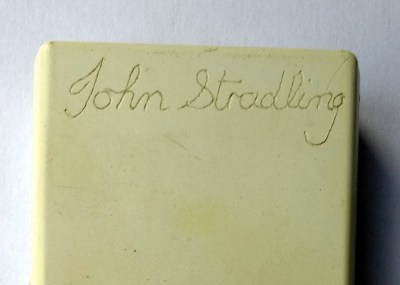
It must be an odd experience to have a random stranger email you out of the blue about a calculator you owned over four decades ago, but Emeritus Professor [John Stradling] of Oxford University’s Nuffield Department of Medicine took it in his stride. No mystery then how it found its way to me as an Oxford-based 1980s teenager.
Professor [Stradling] has now retired from his medical career, but is still an active medical researcher and scientist. He bought the Sinclair as a junior doctor, and told me that it was very much the ‘must have’ accessory at the time as there were a lot of calculations to be made with respect to drugs, or fluids. He revealed that maths is not necessarily the strong point of many doctors through the education system selecting students who study biology instead, and the advent of calculators like the Sinclair was something of a boon to them.
We take a calculator for granted today, it’s an app on a smartphone or if it’s a physical device it’s a lightweight and slim machine with functions way in excess of those on the Sinclair, that runs on next-to-no power. It’s therefore interesting to have a glimpse into where scientific calculators originated, and to have a first-hand account of what it meant to own one in an age of slide rules. The Sinclair Scientific wasn’t the first pocket scientific calculator, nor was it the best of its era. But the story of its development using a chip never intended for the job is a fascinating one, a true hack if ever we saw one. And while today it wouldn’t be the machine you’d reach for from choice, it’s still one with a pleasing aesthetic in an extremely compact form factor. You’d probably be lucky to find one in a rummage sale today, but if one comes your way, snap it up. Meanwhile, enjoy our gallery of the Sinclair Scientific’s internals.


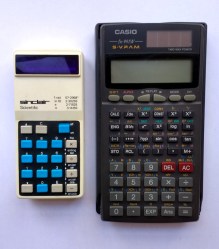
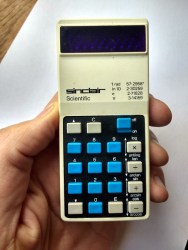
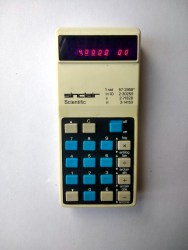

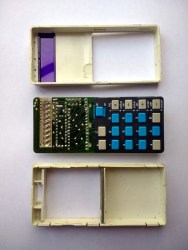
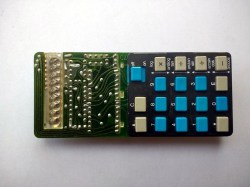
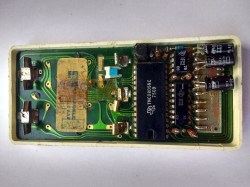
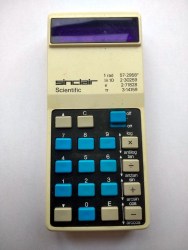

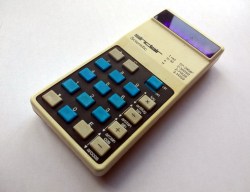
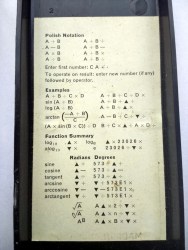
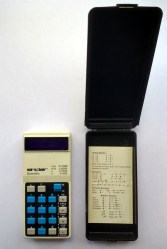
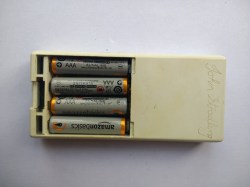















Are the Function keys 3-way rocker switches?
(i.e. Why are there up/down arrows beside each?)
The “+” is also used as the “Enter” key?
Doh! I see the separate Up/Down function keys now!
I’ve got to know how much money you made on this article, cause, I have a bench full of stuff I could tear down and explain.
Just a quick glance, I’ve got High voltage ignitors (12V and 120V, aka, what people use for Jacobs Ladder), a defective turn signal/brake light adapter for pulling trailers (interesting how the analog components are used to create logic for the turn signals, running lights and brakes), a defective controller for a battery powered golf cart (Water is NOT your friend Curtis!!!!)
About a year ago, someone mentioned that bloggers (on WordPress?) get about $16 per article.
IOW, keep your day job.
I love the routing on PCBs of that age, so much more “organic”.
Ditto, need a hand drawn addon for the layout editor.
Would probably help with curtain frequencies and doing on board inductors extra.
Adhesive tape/dough-nut stickers were used on mylar templates, and it was only slightly better than wire-wrap.
It was slow, and very unforgiving if you made errors during drafting.
Note that very few people had access to photo-plotters at the time, and the history of why Gerber became a standard format is actually rather interesting.
I spent many hours in the mid-80s with mylar and tape/doughnuts. I tended to prefer straight lines, but it did take a bit more time. I used to dream about following the traces on the mylar and when I’d drive, sometimes the roads would start looking like circuit board layouts. A very different design method. After that job, I got a job at a division of GM and started doing layouts for hybrid circuits (SMD on alumina substrates) on a Data General S-280 Eclipse running Calma GDSII.
what year did they stop doing those flowy traces? I’ve only seen a couple of. boards like that in my life.
Latest piece of gear I remember seeing them in was a betamax VCR. However, here’s a ZX81, maybe the latest piece Sinclair did like that, because the Spectrum has straight and 45 degree angled traces…
http://www.cosam.org/images/zx81_pcb.jpg
They’d gone like that on the ZX81 by the 4th revision though… (Maybe used different board house also.)….
https://echorod.home.xs4all.nl/zx/ZX81ISS4botPCB.jpg
GAH, derp, that’s a remade one not a Sinclair original, but looked close to what they did with Spectrum doh.
That brings back some very fond memories. I was in 6th form in school doing double maths and physics A-level (in the UK – that’s about 17 years old) and bought a Sinclair Scientific by mail order. Being an electronics enthusiast, I of course had to buy the kit and solder it together myself. All my contemporaries were agog when I could get logs, sine, cosine and tangents with just a few button presses while they had to leaf through their books of tables for the same answer. It didn’t come without it’s bugs though. A typical schoolboy trick was to confuse the poor thing by asking it sine(9.0). This would promptly start the display counting up for some seconds then go blank. A power cycle was the only thing that would sort it out.
Oh happy days!
This was the first calculator I purchased as a college student to replace my slide rule (which I still have), but I purchased mine as a kit, an option Sinclair offered early on. I had to solder in most of those components, and it did work in the end. If I remember correctly, it only had 3 or 4 digits of precision, and always displayed the results in exponential (“scientific”) notation, and was kind of slow, so it wasn’t as big an improvement over a slide rule as one might think. Sadly, I must have tossed it out at some point.
The accuracy was worse than that for the transcendental functions. For once in his life Clive Sinclair didn’t overstate his product’s performance: it was a slide rule replacement.
Since the ROM contained 320 instructions for *everything*, it is remarkable there are any transcendental functions at all. Most people couldn’t even fit a keyboard handler in 320 instructions!
AAAs aren’t that cheap now comparative to AAs, harder to find in bulk packs etc.. If I get a choice between something taking AAA and AA I’ll take the AA powered one even if it’s a bit bulkier.
In the context of this article, I’d say you are trolling, but dang it – I can’t agree more. I loathe devices that require AAA batteries. Half the capacity at twice the price. And rarely does the form factor of the device require the minute space/weight savings.
Case in point – I have a PlanetBike 2W LED headlight that runs on 2 x AA’s. So clearly there’s some kind of joule thief/voltage pump in there along with active current regulation. Works great! They also sell a fairly impressive strobing red LED tail light. Red LED’s have a lower voltage drop, and so I figured they’d work their magic and run it off just 1 AA. Nope. 2 x AAA’s. Sigh.
Coin or button cells are worse.
Incredibly tiny capacity, costs a ton, has to be recycled as hazardous waste, impossible to find the exact right size in a pinch.
Oh, and the reason they don’t like using joule thieves is because you can’t get 100% duty cycle out of it, and it’s actually quite inefficient, so while you can build a light that runs on a single AA cell, it’s going to take a bit more complexity in the boost circuitry to get it operating in a satisfactory manner.
The joule thief “works”, in the sense that you do get a glimmer of light for a long time, but it’s not actually a very good substitute for just having a higher voltage to begin with.
Also, your 2 W LED headlight is quite unlikely to actually be 2 W in power because 1 Watt per AAA cell is really pushing it and it would only run for maybe half an hour. The manufacturers just like to cheat a lot, because there’s no standards for bike lights. It may be a 2 W diode running at a lower current, or a “2 Watt equivalent”, or “2W” as in not power but a model designation – or just plain old lying their pants off.
There are “white” diodes that work at voltages between 2.6 – 3.0 V which can operate directly off of a pair of AAAs without any regulation whatsoever.
+1
joule thief is only a thief when said cells are “stolen” from the trashbin…
you want about 2-and-a-half cells per white LED; not really possible.
and last, yeh, all LED fixtures have THREE RATINGS and it is IMPOSSIBLE to know what you really got until you find out and understand ALL THREE: the rating of the LED itself, the actual power into the LED, and the power into the powersupply/driver. if yer input is 1w and power to LED chip is halfwatt, then poor efficiency excess heat, if LED is 1w and there is 1W going into the LED itself then poor lifetime/heat/efficiencyshift/colorshift, if power consumed INTO converter/driver is far less then LED rating it wont be nearly as bright as youd expect.
oh, and dont forget the (hopefully) obvious; if it contains 9 * 5mm
and not to mention the mis-placed decimal!
almost reminds me of speakers rated in P.M.P.O. … 2w/ch = 350wPMPO
If you’re a sucker for vintage stuff like me I think it’s just beautiful.
Bubble display an all.
Took enough of them apart.
Calculators with LED bubble displays hide in fear of Star Wars light saber replicators. https://www.therpf.com/showthread.php?t=73545
I still think the Sinclair Scientific’s form factor is excellent, unlike its arithmetic.
I still have my Sinclair Scientific from 1975, which only cost £25 at a corner-shop pharmacy next to the Royal Institution. It was affordable, unlike the HP35. (The first time I was able to use an HP35 was at university, where there was one bolted to the desk in the library’s science section)
Last time I powered mine up, it worked but some of the keys were unreliable. Now that I’ve got some Caig DeOxit, I ought to have another go at resurrecting it.
That’s interesting, check out my comment about my Sinclair Scientific Programmable further down!
Wow! Cool story. I’ve been looking for a good calculator for some time now. My workhorse is a TI-82. I hate the screen and the leopard (xkcd 1031) But the ability to look back at previous calculations and do things step-by-step is its biggest virture. Also, the Z80 it uses sucks at quadradics.
If you like RPN, which I do, then there are many HP calculator emulations available for Windows/WINE; I use the HP15C emulator
The TI-82 was a good calculator, but always felt too limiting. I had a TI-85 for a while, and it was certainly nice, but still, for all it gained, it gave up some things the TI-82 did better. I did upgrade my TI-85 to a TI-86 letter on. The expanded memory was a nice change, but still had the same overall limitations.
In the late 90s, I used to overclock those TI calculators (mainly so people could run games on them, or speed of calculations). I made enough to buy just about all the models. I really enjoyed the TI-92, cause it had a 68000 processor with a decent clock speed, and brought back some things that I had missed from the TI-82. It even had a full QWERTY leopard! Problem is, it was big, bulky, and really inconvenient… Also had the worst cover I’ve ever seen.
In the end, my favorite TI graphing calculator became the TI-89. Nearly all the benefits of the TI-92, but in the TI-86 case style… Same old leopard though. :P
QWERTY leopard? Cat calculator? ;)
Gotta love xkcd! ;)
What a nice article. I have — for my own accounting — a TI-1250 with a twitchy power switch, and a TI-83+ that doesn’t get much use any more.
It’s amazing how limited they were, considering the excitement at the time. Someone I knew got an HP-35 the first year they were available, a group buy at RCA, but still very expensive in Canada. I think it was the first pocket calculator I saw close up. It was expensive, but a big leap forward.
But I just saw my TI-30, that I got in 1976 or 77, and it was within reach, $30. That seems too low now, but I’d already been scheming about how to but a fifty dollar calculator.
But the TI, must a few years after the HP, had more buttons and could do more. And so much cheaper. Now, I can more functions even cheaper, including binary and hex, with logical functions (who didn’t lust after the TI Programmer calculator in the later seventies?).
The TI-30 came with a bonus, a nicad pack which was probably offered at the time because competition had become vicious. The calculator could run off a 9V battery, but I never did that until much later, the nicad dead. If the calculator was left on, after sine seconds, the display would blank, just the decimal points sequentially flashed to show you the display was “sleeping” , pressing a button got it back.
Mchael
Very cool tear down.
It did get me thinking I have about 20 Of those old and older calculator IC.
I know I did have some 4 bit CPUs as well.
They are in a box marked OLD ICs.\
There are like 200 or 300 ICs in each box. And they are from the 70s.
I started collecting them when I was around 15 years old.
They are for My boys when they get older. Like 20 – 30 years from now.
I figure they should be like worth Gold times 10.
Thank you.
Hi again.
I’m wandering now that I am thinking about them.
I know there are gold plated memory chips in there as well.
I all so know that I have some of the hardest Memory chips to get your hands on.
Sorry Im not going to get the boxes and start giving IC numbers. Sorry
Lets just say if the chips are hard to get, they are in the boxes.
What do you guys think they would be worth now?
Like I said 200 -300 per box.
Just a thought.
Thanks again.
gold, in microchips
like autumn leaves on the ground
a squirrel hops by
Its not the Gold that I’m thinking about.
I’m talking about the vintage and type of the chips.
But, I guess that was my mistake buy the way I phrased it.
You write quite strangely
Like a Japanese haiku
It’s hard to know you
Too Many Meds.
It is hard to keep track some times.
and hard to wright. The brain is not always here.
But I try.
:-)
My current utility garage-sale calculator (25 cent Casio fx-280) has ‘Satan is your Friend’ scratched into the back. No I’m not hunting down the former owner! ;-)
My very first calculator, though, was a four-function fixed 2 decimal point model that cost an astounding $19 (and this was in 1975!!! I cannot remember the maker right now, it was white with a nine digit LED display) I quickly learned to keep track of the decimal place in my head to get higher precision.
So is the ti chip the whole brains of the calculator and hardwired to everything else? I had imagined the Sinclair stuff to be based on z80s.
For comparison see the link to a bit later calculator based on a general purpose cpu.
https://olduino.wordpress.com/2017/04/15/reprogramming-an-1805-based-calculator-in-c/
I think this vintage is a bit early for microprocessors in calculators. They did move on to ‘programmable’ calculators though, so maybe they went Z80.
Introduction/announcement dates…
Sinclair Scientific: 1974
Altair 8080, which kickstarted the microprocessor revolution: 1974
Zilog Z80: 1976
Sinclair MK14: 1977
Sinclair ZX80: 1980
It was a pre-cambrian explosion from the mid 70s to the mid 80s.
Less than 10 years from the Z80 to the ARM1. Wowsers.
Yes indeed.
The only interesting (i.e. novel advantages and practical) computer and software since then are the XMOS xCORE devices and xC.
They have up to 32 cores and 4000MIPS, and i/o times can be specified programmatically to occur on specified clock cycles, 4ns resolution. They are the only devices that guarantee hard real time performance: the IDE calculates the min and max times between i/o or messages.
To a large extent, xCORE is an evolved Transputer, and xC is an evolved Occam.
Nice article. Always interesting to see this kind of thing. I have a Sinclair Cambridge Programmable. Very similar look and form factor and an interesting little machine to play with, even today.
Cool! I have one too, because a kind colleague at work gave me one. However, it doesn’t quite work. There are possibly two problems.
Firstly, keys appear intermittent. I took the unit apart and saw that the soldered pads for the keys appeared to have worn off, so I re-tinned them. But I also think there’s a problem with the display chip, which I figure could be causing the calculator chip to mis-read the keys too. Have you seen this kind of problem?
Thanks for your interest. It brings back many happy memories of the time I spent programming the Sinclair Scientific.
Did you, at any point, use a slide rule in your work? I do hope so, however unlikely it might be! Or log tables, that would be just as good.
And thank you so much for the Sinclair Scientific.
I still have the slide rule I used at school and university. Everyone accepted that pi^2 = g = 10 :) As for four-figure tables, I used them at school, and probably have a set of 3 or 4 figure tables in a reference book of constants.
I bought a slide rule when I was an undergraduate in 1964, but didn’t use it much because I had wasted most of my childhood teaching myself to be very good at mental calculating. If only I had known that small calculators were coming, I wouldn’t have bothered :)
Clive Sinclair never used a calculator, but always carried and used a small circular slide rule.
Hmmm, are you the REAL Nigel Searle who wrote the ROM for the Sinclair Scientific?
I think so :) It would be a big coincidence if I were not.
Hi Nigel, that’s really amazing! The reason I didn’t cotton on that you must be the REAL Nigel Searle is because I have a later programmable White Sinclair Scientific (with the grey keys) and assumed you were referring to programming it, rather than actually developing the ROM for the original (though I knew Nigel Searle did develop the ROM from the Ken Sherrif Sinclair Scientific blog post).
I was wondering if I could ask you a few questions about Science Of Cambridge and Sinclair Research for a forthcoming
http://oneweekwonder.blogspot.co.uk
Blog post. If you google me, you should find out if it’s worth your while getting in contact, and if so, i look forward to hearing from you. No worries if not.
-best regards from Julz
I’d be happy to try to answer any questions you might have about Science of Cambridge and Sinclair Research. You can PM me through FB; I’m the Nigel Searle in Venice, Florida.
Did you miss Nigel’s comments on the previous post about this machine, Julian? It’s well worth a look. https://hackaday.com/2013/08/30/ken-shirriff-completely-reverse-engineers-the-1974-sinclair-scientific-calculator/#comment-1481881
Who knows whether the big IC is a “calculator ic” or microcontroller, but if the latter it’s not useful as a general microprocessor.
Ironically, I remember some articles in the hobby computer magazines for using a scientific calculator IC as a math processor. It just needed interfacing to the computer’s bus. It was slow, but provided all the calculator functions without having to write the software. This was when real math coprocessors were expensive and very uncommon. And speed was relative, since the CPUs were running at 1MHz generally.
Michael
Who knows? Lots of people! See the linked article by Ken Shirriff, at https://righto.com/sinclair, and the predecessor article at https://righto.com/ti
I sort of like those old LED displays, although I can understand why they went away.
I wonder if the vintage 1979, the EC-4001 Radio Shack calc was made by sinclair..very similar. see radio shack catalog.com
Almost certainly the Radio Shack EC-4001 was made by Sinclair. Sinclair made private label calculators for Gillette (which they sold in test markets before deciding not to get into consumer electronics) and Radio Shack. I think Sinclair also did a private label digital multimeter for Radio Shack.
Gillette? I wonder if it had a place to attach detachable razor blades, so the calculator could also be used as a razor?
“Pick up all the pieces of your razor; go back to your bench; and get your Schick together!” -me
Sinclair Oxford 100/Gillette GPA side-by-side
http://www.vintagecalculators.com/html/oxford_100-gillette_gpa.html
I did not immediately realize how TINY this was till I saw the photo with it in the hand… I mean, calling it next to the 28 pin DIP should have been good enough, but to my defense, I got up early and it’s 6 something in the morning! :P
The stylish and compact form factor reminds me of my algebraic Commodore SR7919D. It may not be RPN, but dang if that tiny beauty packs even more functionality into just as small a package!
On the other end of the scale for pocket calculators, I also have my Commodore N-60 “Navigator” and S-61 “Statistician, each with massive shells and as many buttons as their model number’s suggest in the naming! Then there’s my “portable” Monroe 344 Statistician… It takes 4 “D” batteries. It has a handle. It’s about the size of a cassette tape recorder of the era. maybe a bit thicker. If you want “yuge”, then there are some of my 1960s era desktops calculators… I have a 1965 SCM Cogito 240SR, and a Friden EC-132. Both machines are nearly 40 pounds (nearly 18 kg)!
http://farhek.com/a/b/co/commodore-sr7919d-scientific-notation-calculator-red-led-vintage-collectible-usa_scientific-notation-calculator_zener-resistance-bjt-transistor-as-a-switch-application-of-mosfet-synchronou_1100x1136.jpg
BTW, those keys are plastic shells, with screen printed aluminum inserts bonded into a recess in the shell. They look really nice, and actually feel a little bit better than the usually spongy keys on a lot of the other commodore calculators i have. They’re not clicky, though they do have a “tactile” feel when pressed.
Also, the Friden EC-132 I mentioned is an RPN calculator. It’s slightly earlier non-square root version, the EC-130, I think was the first to do RPN.
Wasn’t Friden a company bought by HP to produce its first (desktop) calculators?
Friden was not acquired by HP, and actually produced calculators until 1974. Friden was actually acquired by Singer in 1965 (yes… the company that makes SEWING machines). I presume Singer wanted a company with expertise in complex mechanical processing devices, so they could presumably develop sewing machines with numerous varieties of stitch patterns… Something Friden could probably help them to “program” into the complex mechanics of a high end sewing machine. If you’ve ever seen a Friden STW or SRW mechanical calculator perform a large calculation… It’s truly a sight to behold!
HP had been building mainframe computers for some time already, and were a significant competitor to IBM, Sperry-Rand, and Honeywell in those days. They were already well versed in digital hardware, and their first calculator was the HP9100A, released in 1968. It was developed based off inventor Tom Osbourne’s “Green Machine” calculator prototype.
“Osborne used advanced, digital, finite-state-machine design (which he later named Algorithmic State Machine design or ASM) that he had learned and then greatly extended at UC Berkeley. He developed a 64-bit, microprogrammed processor with operating characteristics that would not be duplicated in a microprocessor for another 30 years or so. He then built a prototype calculator, housed it in a hand-built balsa-wood case, and painted it metallic Cadillac green. He finished the prototype on Chrismas Eve, 1964 and then Tom Osborne went out into the world to find a buyer for his brainchild.”
He tried to market his calculator to a number of companies. Often times, he bailed, due to VERY bad NDAs that would have more or less let the companies he was showing the device to effectively steal his design. IBM offered him a very favorable NDA, but was not interested in the actual invention. IBM’s NDA impressed him, and did not threaten his IP rights, and was the model he worked with from that point on for any companies he showed his calculator to. SCM (Smith Corona-Marchant) wanted to take a look, but already had a design of their own well into development. It was based on a partnership with Manhattan Project mathematician Stan Frankel (that design led to the SCM Cogito 240SR). Osbourne also had previous experience working for SCM, and he was not about to deal with them or their lawyers. LOLnope! :P
“One company that was very interested in Osborne’s calculator design was Friden, the company whose existing electronic calculators had **beaten SCM to market**. As Osborne puts it, he and Friden “waltzed” for about six weeks without getting anywhere. Friden was very eager during that time to get under the green balsa-wood “skirt” of Osborne’s machine for a better look at the electronics. Osborne firmly kept the cover on his calculator and finally called off discussions with Friden when the deal started to smell. He later found out that Friden’s interest was in acquiring and killing his calculator design to prevent any competing company from eating into Friden’s market share.”
**That’s a whole story on it’s own, and not well documented at this source… To shorten it: Stan Frankel went to SCM with his calculator design. SCM had an established mechanical calculator business. They were interested, but cautious. They offered to license it to Friden. If it succeeded, SCM could come up with their own improved model and compete, and would still earn income off the license. If it failed, Friden took the hit. Either way, they got paid… Except Friden wasn’t dumb. They did NOT bite… They beat SCM to market by a couple months with their own original calculator design, the EC-130, a calculator that featured RPN entry.**
So, back to what led to HP’s first calculator. In 1956, a decade earlier, a man named Jack E. Volder developed the CORDIC algorithm (COordinate Rotation DIgital Computer), which computes trigonometric functions (such as sine and cosine) using iterative repetitions of shifts and adds. Digital circuits can easily perform shifts and adds at very high speeds so Volder’s algorithms opened the world of trigonometric computation to electronic computers.
A physicist named Malcolm Macmillan realized that Volder’s CORDIC algorithm held promise as a foundation for a scientific calculator. Macmillan developed a prototype calculator with Volder based on Volder’s CORDIC algorithm and went out to find a buyer for his design. One of the companies he visited was HP”.
HP was interested in the algorithm, but not the somewhat clumsily designed machine that ran CORDIC. They didn’t see a market for it. A guy named Tony Lukes was working for HP in 1965. Lukes had previously worked at SCM with Osborne, and learned of the HP meeting with Macmillan and told management that he knew someone with terrific digital-design skills who could probably develop a good calculator design based on Macmillan’s and Volder’s CORDIC.
So, Tony Lukes convinced HP to bring on Osbourne. All the development was done in house at HP. Tom Osbourne developed his “Green Machine” architecture to integrate Jack Volder’s and Malcolm Macmillan’s CORDIC algorithms into it’s 64 bit microcoded floating point architecture, to create what was then the world’s most advanced scientific calculator, the HP9100A. The HP9100 had a 32 Kbit ROM in 1968… That… That is impressive. They did it with an impressive PC board design that used a grid of sense lines and zigging and zagging traces spread across a 16 layer teflon insulated PC board. They created an inductive memory that used the PC board itself AS the storage medium!
Later, the HP9100B added additional functionality and doubled the memory. The 9100 was the inspiration for the HP-35. The boss literally wanted to be able to fit a 9100 in his pocket.
For my source, and a more detailed history, check out http://www.hp9825.com/html/the_9100_project.html
Small update for clarity… Osborne (no “u”… oops!) worked at SCM and actually left to develop his own calculator because he considered Frankel’s design to be “lacking”. He refused to deal with SCM, and had no intention of letting them market his design. Even when he worked with HP, he agreed to come on board, only if they took him on as a consultant, and not an employee. Really independent guy! He continued consulting for HP for at least a decade.
Thanks for the clarification,
I guess I saw a photos of early Fridens and the HP 9100 and thought they were related!
As well as HP collectors willing to add Fridens to their collections.
Oh yeah, I remember seeing some Singer electronic test equipment years ago, (frequency counter, function or freq gen. or combination) It was impressive, but I heard the rotary switches wore out quickly.
ISTR a funny where by, if you switched in on and off a few times in quick succession, the display started counting…
There was an article decadess ago, (I think in Radio-Electronics magazine) about converting a cheap calculator to a capacitance checker, by using its counting function to time how long the capacitor took to charge.
I wish I had kept/found the article, it was something I wanted to do. But in retrospect, those old calcs are probably more valuable unbutchered.
Amazing article. It is an extra advanced calculator. According to me, let’s buy a calculator which can in our budget and all functions be there that we can have a need and efficiently we should operate and get an answer. I bought Casio calculator from https://www.zencalculator.com/best-calculator-for-chemistry/ with affordable price, and it had excellent functionality, robust and solved my complicated calculation.
Here is my attempt to re-create it in VHDL on FPGA board: https://hackaday.io/project/167457-tms0800-fpga-implementation-in-vhdl
Ran into this bit of nostalgia! Had a kit way back when my young eyes could do that w/o a microscope. Worked great as a smaller 4 function and small slide rule replacement. Keyboard started flaking out after months. Should have saved it for ebay.
I had one at school in England in the 70’s. I loved it becuase it had such elegance and charisma. But the buttons were terrible even when it was new, often recording a double key strike erroneously. The RPN and the scientific notation was a bit of a pain for me, with me not being on The Spectrum. Yet when my school maths department borrowed mine to assess it and decide what calculator to bulk-buy for the pupils, I was sad when my Sinclair got shellacked in comparative tests by the Texas TI30.